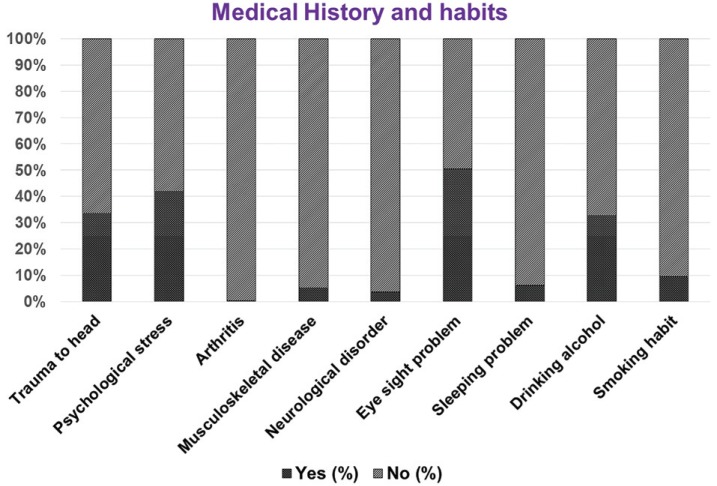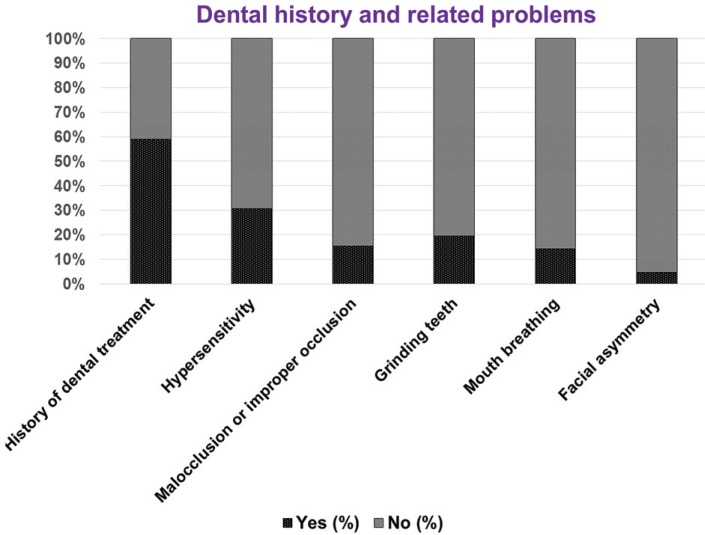J Dent Anesth Pain Med.
2018 Feb;18(1):27-33. 10.17245/jdapm.2018.18.1.27.
An epidemiological study on the prevalence of temporomandibular disorder and associated history and problems in Nepalese subjects
- Affiliations
-
- 1Department of Prosthodontics, Kathmandu University School of Medical Sciences, Dhulikhel, Nepal. dineshrokaya115@hotmail.com
- 2Department of Community Dentistry, Faculty of Dentistry, Western University, Pathum Thani, Thailand.
- 3Department of Oral Medicine and Radiology, Kathmandu University School of Medical Sciences, Dhulikhel, Nepal.
- 4Department of Oral and Maxillofacial Surgery, Faculty of Dentistry, Mahidol University, Bangkok, Thailand.
- 5Department of Orthodontics, Ale Dental Hospital, Butwal, Nepal.
- KMID: 2405380
- DOI: http://doi.org/10.17245/jdapm.2018.18.1.27
Abstract
- BACKGROUND
Temporomandibular disorder (TMD) represents a subgroup of painful orofacial disorders involving pain in the temporomandibular joint (TMJ) region, fatigue of the cranio-cervico-facial muscles (especially masticatory muscles), limitation of mandible movement, and the presence of a clicking sound in the TMJ. TMD is associated with multiple factors and systemic diseases. This study aimed to assess the prevalence of TMD in Nepalese subjects for the first time.
METHODS
A total of 500 medical and dental students (127 men and 373 women) participated in this study from May 2016 to September 2016. The Fonseca questionnaire was used as a tool to evaluate the prevalence of TMD, and Fonseca's Anamnestic Index (FAI) was used to classify the severity of TMD.
RESULTS
The majority of the participants with TMD had a history of head trauma, psychological stress, and dental treatment or dental problems. The prevalence of TMD in Nepalese students was mild to moderate.
CONCLUSIONS
The prevalence of TMD in Nepalese subjects was mild to moderate. The majority of the study subjects had eyesight problems, history of head trauma, psychological stress, and drinking alcohol and had received dental treatments.
MeSH Terms
Figure
Reference
-
1. de Santis TO, Motta LJ, Biasotto-Gonzalez DA, Mesquita-Ferrari RA, Fernandes KP, de Godoy CH, et al. Accuracy study of the main screening tools for temporomandibular disorder in children and adolescents. J Bodyw Mov Ther. 2014; 18:87–91. PMID: 24411155.
Article2. Manfredini D, Lobbezoo F. Relationship between bruxism and temporomandibular disorders: a systematic review of literature from 1998 to 2008. Oral Surg Oral Med Oral Pathol Oral Radiol Endod. 2010; 109:e26–e50.
Article3. Goldstein BH. Temporomandibular disorders: a review of current understanding. Oral Surg Oral Med Oral Pathol Oral Radiol Endod. 1999; 88:379–385. PMID: 10519741.
Article4. Da Fonseca DM, Bonfante G, Valle AL, de Freitas SFT. Diagnóstico pela anamnese da disfunção craniomandibular. Rev Gauch de Odontol. 1994; 4:23–32.5. Bonjardim LR, Gavião MB, Pereira LJ, Castelo PM. Anxiety and depression in adolescents and their relationship with signs and symptoms of temporomandibular disorders. Int J Prosthodont. 2005; 18:347–352. PMID: 16052791.6. Pesqueira AA, Zuim PR, Monteiro DR, Ribeiro Pdo P, Garcia AR. Relationship between psychological factors and symptoms of TMD in university undergraduate students. Acta Odontol Latinoam. 2010; 23:182–187. PMID: 21638957.7. Habib SR, Al Rifaiy MQ, Awan KH, Alsaif A, Alshalan A, Altokais Y. Prevalence and severity of temporomandibular disorders among university students in Riyadh. Saudi Dent J. 2015; 27:125–130. PMID: 26236125.
Article8. Wahid A, Mian FI, Razzaq A, Bokhari SAH, Kaukab T, Iftikhar A, et al. Prevalence and severity of temporomandibular disorder (TMD) in undergraduate medical students using Fonseca's questionnaire. Pakistan Oral Dent J. 2014; 31:38–41.9. Modi P, Shaikh SS, Munde A. A cross sectional study of prevalence of temporomandibular disorders in university students. Int J Sci Res Publ. 2012; 2:1–3.10. Nomura K, Vitti M, Oliveira AS, Chaves TC, Semprini M, Siéssere S, et al. Use of the Fonseca's questionnaire to assess the prevalence and severity of temporomandibular disorders in Brazilian dental undergraduate. Braz Dent J. 2007; 18:163–167. PMID: 17982559.11. Conti PC, Ferreira PM, Pegoraro LF, Conti JV, Salvador MC. A cross sectional study of prevalence and etiology of signs and symptoms of temporomandibular disorders in high school and university students. J Orofac Pain. 1996; 10:254–262. PMID: 9161230.12. Shiau YY, Chang C. An epidemiological study of temporomandibular disorders in university students of Taiwan. Community Dent Oral Epidemiol. 1992; 20:43–47. PMID: 1547612.
Article13. Becker IM. Occlusion as a causative factor in TMD. Scientific basis to occlusal therapy. N Y State Dent J. 1995; 61:54–57.14. Joo SJ, Kang DW, Lee HS, Jin SY, Lee GJ. Re-restoration of temporomandibular joint disorder acquired after implant prosthetic restoration using T-Scan: a case report. J Korean Acad Prosthodont. 2016; 54:431–437.
Article15. Park KS, Lee CH, Lee JW. Use of a botulinum toxin A in dentistry and oral and maxillofacial surgery. J Dent Anesth Pain Med. 2016; 16:151–157. PMID: 28884147.
Article16. Chi SI, Kim HJ, Seo KS, Lee JH, Chang J. Local anesthesia of the temporomandibular joint to reduce pain during mouth opening for dental treatment in a patient with spinal muscular atrophy. J Dent Anesth Pain Med. 2016; 16:137–140. PMID: 28879307.
Article17. Ebrahimi M, Dashti H, Mehrabkhani M, Arghavani M, Daneshvar-Mozafari A. Temporomandibular disorders and related factors in a group of Iranian adolescents: A cross-sectional survey. J Dent Res Dent Clin Dent Prospects. 2011; 5:123–127. PMID: 22991620.
- Full Text Links
- Actions
-
Cited
- CITED
-
- Close
- Share
- Similar articles
-
- The prevalence of temporomandibular disorders in 16~18 aged subjects at Yongin, Kyungkido, Korea
- The relationship between dental occlusion and temporomandibular joint disorder
- A study of masseteric silent period on the normal subjects and temporomandibular disorder patients
- Evaluation of mandibular condylar bony changes in temporomandibular disorders using Polytome-U images
- A study on simultation of the mandibular movement of the patients with temporomandibular joint disorder



